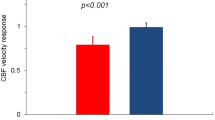Abstract.
Background: Reopening of the infarct-related coronary artery is the treatment of choice in the clinical setting of acute myocardial infarction. Nevertheless the removal of the total occlusion obtained either by thrombolysis or by primary angioplasty is followed by the ischemia/reperfusion sequelae. One of many proposed mechanisms playing a role in ischemia/reperfusion damage is a persistent increase in vasoconstrictor tone, which reduces cardiac function and impairs myocardial blood flow during primary percutaneous coronary intervention in acute myocardial infarction (PAMI).
Methods: To investigate early neurohumoral changes during PAMI we enrolled 18 patients, who were collated to 13 patients with stable angina undergoing elective PTCA. To evaluate angiotensin II (AngII), endothelin-1 (ET-1), vasopressin (AVP), norepinephrine (NE), troponin T (TNT), creatinephosphate kinase (CPKM) and isoenzyme MB (CPKMB), we collected blood from the pulmonary artery before and immediately after the infarct-related artery (IRA; TIMI 0 → 2–3) or culprit lesion revascularization. Hemodynamic and angiographic LV-function parameters were compared to biochemical data. Corrected TIMI-frame count (CTFC) was used as an index of coronary blood flow and correlated to the biochemical measurements.
Results: CTFC in the IRA correlated inversely (p = 0.03; r = −0.51) with left ventricular ejection fraction measured after 10 days, and positively (p = 0.03; r = 0.54) with the maximal amount of LDH released after onset of AMI. There was an abrupt and long lasting rise in ET-1 (+65 %; p < 0.001) and an instant short lasting increase in AVP (+37 %; p < 0.05), whereas NE concentrations were elevated prior to PAMI and remained elevated during reperfusion. Correlations with CTFC were found for ET-1 (p = 0.01; r = 0.61) and NE (p = 0.01; r = 0.58) during reperfusion. The extent of left ventricular dysfunction correlated with the concentrations of AVP and NE during reperfusion.
Conclusions: There is evidence for a distinct pattern of neurohumoral activation during early reperfusion in acute myocardial infarction. In particular, we documented substantial increases in AVP and ET-1. Left ventricular wall-stress appears to be involved in the release of AVP. Elevated levels of ET-1 and NE are associated with impaired angiographic reperfusion and increased myocardial damage after mechanical recanalization.
Similar content being viewed by others
Author information
Authors and Affiliations
Additional information
Received: 13 December 2001, Returned for 1. revision: 14 January 2002, 1. Revision received: 10 April 2002, Returned for 2. revision: 30 April 2002, 2. Revision received: 10 May 2002, Accepted: 13 May 2002
Rights and permissions
About this article
Cite this article
Schäfer, U., Kurz, T., Jain, D. et al. Impaired coronary flow and left ventricular dysfunction after mechanical recanalization in acute myocardial infarction: role of neurohumoral activation?. Basic Res Cardiol 97, 399–408 (2002). https://doi.org/10.1007/s003950200049
Issue Date:
DOI: https://doi.org/10.1007/s003950200049




